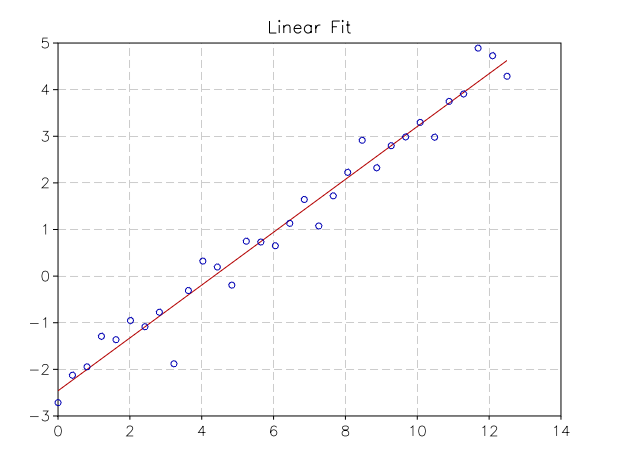Linear Least Squares fit¶
Overview¶
This chapter describes routines for performing least squares fits to experimental data using linear combinations of functions. The data may be weighted or unweighted, i.e. with known or unknown errors. For weighted data, the functions compute the best fit parameters and their associated covariance matrix. For unweighted data, the covariance matrix is estimated from the scatter of the points, giving a variance-covariance matrix.
Linear Fit Functions¶
- linfit(X, y[, w])¶
Perform a linear fit for the observations
yusing the model matrixX. It returns a vector with the coefficients of the fit, the residual chi square and the covariance matrix. You can optionally provide the weightswof the observations to obtain a weighted linear fit. The argumentyshould be a column matrix of length N while the modelXshould be a N x M matrix where M is the number of basis in the linear model.- Example
Let us suppose that we have two column matrices, x and y, and we want to make a linear fit of y versus x. We first build the model matrix and then we use it to perform the linear fit:
X = matrix.new(n, 2, |i,j| j == 1 and 1 or x[i]) c, chisq, cov = linfit(X, y)
The function returns the fit coefficients, the residual chi square and the covariance matrix.
Complete Example¶
We give a complete example where a set of (x, y) observations are simulated and a linear fit is done:
x0, x1, n = 0, 12.5, 32
a, b = 0.55, -2.4
xsmp = |i| (i-1)/(n-1) * x1
r = rng.new()
x = matrix.new(n, 1, xsmp)
y = matrix.new(n, 1, |i| a*xsmp(i) + b + rnd.gaussian(r, 0.4))
-- model matrix for the linear fit
X = matrix.new(n, 2, |i,j| j == 1 and 1 or x[i])
print('Linear fit coefficients: ')
c, chisq, cov = num.linfit(X, y)
print(c)
fit = function(x) return c[1]+c[2]*x end
p = graph.fxplot(fit, x0, x1)
p:addline(graph.xyline(x, y), 'blue', {{'marker', size=5}})
p.title = 'Linear Fit'
